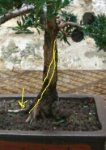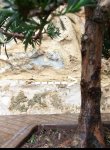maroun.c
Omono
Images could be taken - front on -------- not slightly above.
What Maroun is seeing, isn't what we see.
Advice for styling will be weaker.
Good Day
Anthony
Sorry about that. Will post level shots as soon as back home.
Images could be taken - front on -------- not slightly above.
What Maroun is seeing, isn't what we see.
Advice for styling will be weaker.
Good Day
Anthony
I kinda preferred the previous front for the added nebari it offered. Now ur post git me rethinking that.That base there made me exclaim out loud....
OH shit!
That should be the front....
But....
Square one.....is a octagon!
Sorce
What would you do going forward if the right side is the front?





Stacy,
would it not have been simpler to suggest Maroun get 10 to 20 test plants to experiment on, and apply the experience to his
main plant [ illustrated in this topic ] ?
Good Day
Anthony
And thank you so much.learner.
All everyone else had to do, was read a post that probably took a couple of minutes to go through... at the longest?
I personally would suggest beyond anything else when contemplating a style of a piece of material is two things...
First and most important, is that you learn what the material is.
Study it's growth patern... of how it grows, how it does not grow. And study examples that other have made using this material, into Bonsai.
And Secondly, and equally important... Study the actual material that you wish to style.
Do your homework. I say this not to be mean... but, rather than throwing out willy nilly ideas of what one should make the tree into... you will find that if you do these 2 steps... the material will actually tell you how it should be styled. The sooner you learn this the better off you will be.
So...
Pordacarpus
It is a conifer. There is a dwarf variety, which I believe this might be? However, the non-dwarf variety will reduce down to pretty much the same size given the right conditions. These being the more foliage one has the smaller the leaves as well drier conditions within the soil.
They have compartmentalized trunks. This is important! This is to say, that like junipers, they have individual veins that feed each branch. Think of a vine, and how smaller vines will often twist together, and around each other, to form one main vine. They do not bud back on the trunk very easily, without severe pruning above... and lastly the foliage does not grow very sparce... this is to say that any design, for the most part will have to include the weight of a very dense foliage padding.
What then does all of this tell us?
Well... First off, let's consider the Foliage in comparison to the trunk size of the material.
The trunk is very lean and elegant. Which is fine if one is able to reduce the amount of foliage, by either making the foliage very compact and in close to the trunk, which can be done, and the material could benifit from... however, because the material naturally has a very dense growth pattern, there is only so far this will take you with improving it's design, seeing that even if you manage to only have a couple of pads of foliage in tight... it might still feel very heavy.
Second option with a very lean trunk, is to have far outstretched branching, with very minimal foliage giving a sparce and open feel, to balance out the weight of foliage in comparison to the trunk... which here again, because of its foliage growth patern, this material will not allow for.
By knowing and understanding these things... this then automatically tells us that the any design one comes up with, with the trunk as it currently is... is going to feel to heavy for the scale of the trunk... and make the tree feel "Young" and "Small". Which in Bonsai is not what we want.
Next, let's take the concept of it not budding back on the trunk very easily. Your material lacks a lot of branching coming off the trunk.
This means you will either need to severely cut back what you do have, in order to hopefully achieve some new budding, and possible branching. Which could happen, and could not... and if so, will it be in a usable location? A lot of work for a maybe...
The other approach to this issue, is then to design a style where rather than trying to chase back... you grow out. With the understanding that if you grow out, seeing that the material will naturally want to grow... it's new buds will be more centralized to the tips and thus you will always have the possibility for new branching.
Lastly, if this material is compartmentalized in its growth pattern... with one root often feeding only one branch... killing off, or removing any branching might kill off portions of the trunk below.
Which is bad if you do not want this to happen... good if you can use this in the tree's design.
One more thing to note with this type of material... a compartmentalized trunk, means Good Luck improving the nebari in any way you would like it too... other than perhaps grafting a new root.
Pordacarpus often will be found with a very radiating root flare... although often this radiation, will be one on top of another as the tree sent down a centralized Tap Root.
Does a Conifer have to have a nice radiating nebari? If it is styled as most conifers are... then I would say no... due to the notion that very few conifers often achieve this. However, Pordacarpus are a funny breed of Conifers... seeing that they often can easily be styled in a way that most Deciduous trees are... kinda like a big oak tree is, with long out stretched branching. And you will find this quite a common style in a lot of Asian countries, where they work with them.
A couple things to note... these examples are usually the size of a car, if not bigger... and have tons of branching coming off of the trunk... and almost require a nice radiating nebari.
Where would I start with this material?
I would start by following and identifying the veins of this tree. Before anything else.
Since, you do not have a radiating nebari, you do not have tons of branching, you have a tall lean trunk with few options at msking multiple trunks... No reason dwelling on trying to make a deciduous looking tree.
I would run with the positives it does have then... and go with more of a Conifer style approach. And with conifers it is all about deadwood. Podacarpus have very strong wood. And support deadwood very well with their design. You have removed, or someone has removed a large branch on what you have picked as your front. This vein that feed this might then be dead. So, you might already have deadwood hidden underneath it's bark that has not fallen off. Sometimes you will get a vein that does tie back into another, or has grown visually together. If this is the case, you can eliminate slowly the side where it has tapped into overtime and make the live portion smaller.
Pordacarpus also as they age, often will put on some very awesome twisting movement to their trunks due to their individual veins growing. When, I looked close at your trunk... your tree has begun this journey. Use this. It is a cool feature...
View attachment 136338
Follow this vein that I have outlined in yellow up the trunk, around the other side... and tell us where it goes... this for me is a good jumping off point to where to begin with it's style.
In Bonsai, we want to put our best foot forward... the best thing about this piece of material, is that you have nice movement within a straight trunk. This nice movement if utilized well can make or break the tree. Everything else, including it's style should be centered around and made to work with... what is going on in this highlighted picture.
Learn your material before doing a style. Do your homework. Figure out what are it's negatives, it's positives... how it grows.
99 percent of Bonsai is not Art... it is a Math Problem. Eliminating one part of the equation at a time.
Oh... and might I suggest using the rear of the tree. The opposite side of your chosen front.

hi this might be helpfulThanks for all the info. Confess I have never heard about compartments and veins as you explained. I tried to identify the veins to the best of my knowledge and I believe one goes to the thick branch that I plan to take out and another goes to the branch that continues the trunk after the first bifurcation. It's not very visible but I tried taking some closeup shots.
View attachment 136478
I looked at the back side as you mention considering it as front and it unfortunately loses all the motion in the trunk which is not visible from the back.
Will try to find some reading on the compartments and veins and how to better utilize those when planing a Tree. Appreciate if u can indicate any good readings.



And thank you so much.
I didn't know squat about podocarpus until now.
